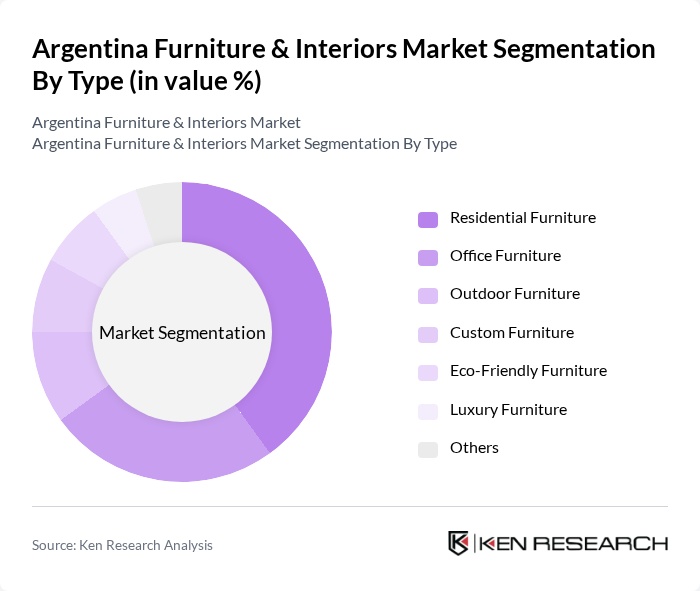Region:Central and South America
Author(s):Rebecca
Product Code:KRAA3343
Pages:86
Published On:September 2025

By Type:The furniture market can be segmented into various types, including Residential Furniture, Office Furniture, Outdoor Furniture, Custom Furniture, Eco-Friendly Furniture, Luxury Furniture, and Others. Among these, Residential Furniture is the most dominant segment, driven by the increasing trend of home renovations and the growing interest in interior design. Indoor furniture represents the largest category, with outdoor furniture emerging as the fastest-growing segment due to increased focus on outdoor living spaces and patio furnishing. Consumers are increasingly investing in quality and stylish furniture for their homes, leading to a surge in demand for this category.

By End-User:The market can be segmented into Residential, Commercial, Hospitality, and Government end-users. The Residential segment is the largest, driven by the increasing number of households and the trend of home improvement. Consumers are investing more in their living spaces, leading to a higher demand for various types of furniture tailored to personal preferences and styles.

The Argentina Furniture & Interiors Market is characterized by a dynamic mix of regional and international players. Leading participants such as Grupo Maderero, Estudio de Muebles, Muebles Dico, Muebles Jamar, Muebles Gama, Muebles Ledesma, Muebles Loma, Muebles Tavares, Muebles Luján, Muebles Lira, Muebles Lujoso, Muebles Casa, Muebles del Sur, Muebles de Argentina, Muebles y Decoración contribute to innovation, geographic expansion, and service delivery in this space.
The Argentina furniture and interiors market is poised for transformation as urbanization continues to rise and e-commerce adoption accelerates. With a growing emphasis on sustainability, manufacturers are likely to innovate eco-friendly products that cater to environmentally conscious consumers. Additionally, the increasing demand for customized furniture solutions will drive local manufacturers to enhance their offerings, ensuring they meet diverse consumer preferences while navigating economic challenges and competition from imports.
| Segment | Sub-Segments |
|---|---|
| By Type | Residential Furniture Office Furniture Outdoor Furniture Custom Furniture Eco-Friendly Furniture Luxury Furniture Others |
| By End-User | Residential Commercial Hospitality Government |
| By Distribution Channel | Online Retail Brick-and-Mortar Stores Wholesale Distributors Direct Sales |
| By Material | Wood Metal Plastic Fabric |
| By Price Range | Budget Mid-Range Premium |
| By Style | Modern Traditional Contemporary Rustic |
| By Functionality | Multi-Functional Space-Saving Standard Others |
| Scope Item/Segment | Sample Size | Target Respondent Profiles |
|---|---|---|
| Residential Furniture Purchases | 120 | Homeowners, Interior Designers |
| Commercial Furniture Solutions | 90 | Office Managers, Facility Coordinators |
| Custom Furniture Design Trends | 60 | Architects, Custom Furniture Makers |
| Consumer Preferences in Interiors | 100 | General Consumers, Home Decor Enthusiasts |
| Market Trends in Sustainable Furniture | 70 | Sustainability Advocates, Eco-conscious Consumers |
The Argentina Furniture & Interiors Market is valued at approximately USD 11.7 billion, reflecting a significant growth trend driven by urbanization, rising disposable incomes, and increased interest in home improvement and interior design.